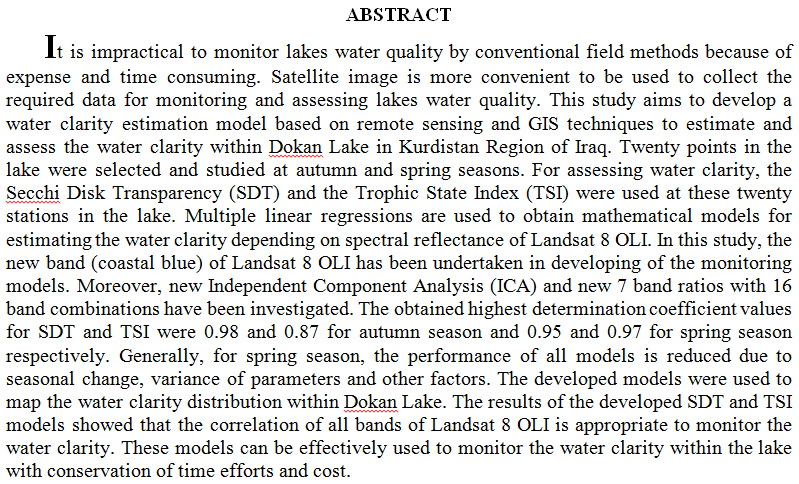
This paper presents an experimental study of cooling photovoltaic (PV) panels using evaporative cooling. Underground (geothermal energy) water used to extract heat from it during cooling and cleaning of PV panels. An experimental test rig was constructed and tested under hot and dusty climate conditions in Baghdad. An active cooling system was used with auxiliary an underground water tank to provide cold water as a coolant over both PV surfaces to reduce its temperature. The cellulose pad has been arranged on the back surface and sprays cooling on the front side. Two identical PV panels modules used: without cooling and evaporative water cooling. The experiments are comprised of four cases: Case (I): backside cooling, Ca
... Show More (13)
(13)
The aim of this study was to investigate antibiotic amoxicillin removal from synthetic pharmaceutical wastewater. Titanium dioxide (TiO2) was used in photocatalysis treatment method under natural solar irradiation in a tubular reactor. The photocatalytic removal efficiency was evaluated by the reduction in amoxicillin concentration. The effects of antibiotics concentration, TiO2 dose, irradiation time and the effect of pH were studied. The optimum conditions were found to be irradiation time 5 hr, catalyst dosage 0.6 g/L, flow rate 1 L/min and pH 5. The photocatalytic treatment was able to destruct the amoxicillin in 5 hr and induced an amoxicillin reduction of about 10% with 141.8 kJ/L accumulate
... Show More (14)
(14)
In this work, an inventive photovoltaic evaporative cooling (PV/EC) hybrid system was constructed and experimentally investigated. The PV/EC hybrid system has the prosperous advantage of producing electrical energy and cooling the PV panel besides providing cooled-humid air. Two cooling techniques were utilized: backside evaporative cooling (case #1) and combined backside evaporative cooling with a front-side water spray technique (case #2). The water spraying on the front side of the PV panel is intermittent to minimize water and power consumption depending on the PV panel temperature. In addition, two pad thicknesses of 5 cm and 10 cm were investigated at three different water flow rates of 1, 2, and 3 lpm. In Case #1,
... Show More (5)
(5)
Abstract
The aim of this paper is to investigate and discuss the mechanisms of corrosion of epoxy coatings used for potable water tanks. Two distinct types of Jotun epoxy coatings: Tankguard 412 contained polyamine cured epoxy and Penguard HB contained polyamide cured epoxy, were tested and studied using the electrochemical impedance spectroscopic (EIS) method. The porosity of epoxy coatings was determined using EIS method. The obtained results showed that the two epoxy coatings have excellent behavior when applied and tested in potable water of Basrah city. Polyamine is more resistance to water corrosion compared to polyamide curing epoxy and has high impedance values. Microscopic inspection after te
... Show More (3)
(3)
 (21)
(21)
 (12)
(12)
This study concerns the removal of a trihydrate antibiotic (Amoxicillin) from synthetically contaminated water by adsorption on modified bentonite. The bentonite was modified using hexadecyl trimethyl ammonium bromide (HTAB), which turned it from a hydrophilic to a hydrophobic material. The effects of different parameters were studied in batch experiments. These parameters were contact time, solution pH, agitation speed, initial concentration (C0) of the contaminant, and adsorbent dosage. Maximum removal of amoxicillin (93 %) was achieved at contact time = 240 min, pH = 10, agitation speed = 200 rpm, initial concentration = 30 ppm, and adsorbent dosage = 3 g bentonite per 1L of pollutant solution. The characterization of the adsorbent, modi
... Show More (24)
(24)
 (26)
(26)
The study aims to identify the extent of the availability of administrative empowerment and the implementation of remote supervision in relation to two variables with respect to the employees of the Saudi Ministry of Education. The study included (456) male and female supervisors. The questionnaire has been administrated to collected data related to the research aims. The results indicated that both the extent of the availability of administrative empowerment and the implementation of remote supervision is of an average degree. There is a significant correlation relationship (p<0.05) between administrative empowerment and remote supervision of the educational supervisors of the Saudi Ministry of Education. The research recommends that
... Show MoreThe current research examines the employment of indicators of stereotypes and the dimensions of organizational clarification to achieve planned organizational behaviour on a sample of employees in a number of departments of the Faculties of Engineering, University of Kufa, for a sample of (122) teaching staff. This research proposes the use of positive indicators of stereotypes for both the organization and employees and their awareness of what they want to obtain and what should be done for both parties and the removal of organizational clarity represented by the functional dimension that explores to what degree the employee's understanding of the internal strategy of the organization and the strategic dimension that searches fo
... Show MoreBackground: Severe acute respiratory syndrome coronavirus 2 (SARS-Cov-2) is still a severe threaft for human health currently, and the researches about it is a focus topic worldwide.
Aim of the study: In this study, we will collect some laboratory results of the patients with coronavirus disease (COVID-19) to assess the function of liver, heart, kidney and even pancreas.
Subjects and Methods: Laboratory results of the patients with COVID-19 are collected. The biochemical indices are classified and used to assess the according function of liver, heart, kidney; meantime, and blood glucose is also observed and taken as an index to roughly evaluate pancreas.
Results: There were some in
... Show More (1)
(1)
 (5)
(5)
 (2)
(2)
